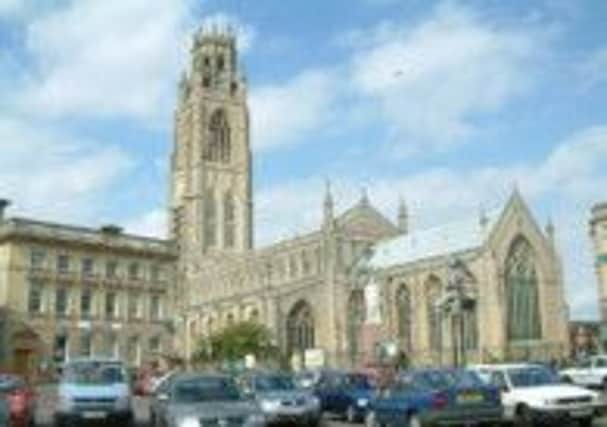Travel: Lincolnshire’s ancient markets


The punters have been standing in the cold all night beside their goods in the old cow pen arena which was in former times called ‘Mill Hill’. Meanwhile auctioneer Ian Naylor arrives at 6am to log goods and everything goes under the hammer at 10am.
The ancient Bargate precinct hasn’t changed all that much since the town got its market charter in 1308. There’s a famous painting entitled ‘Market Day’ at the town library (currently being refurbished) of the old market in Victorian times where thousands of sheep are being sold.
Advertisement
Hide AdAdvertisement
Hide AdThe New England Hotel where I stayed was formerly the Cross Keys and the Red Cow and remains omnipresent reminders of times past.
The weekly Wednesday stock market established in 1847 ceased a few decades back after which the area became a car park-cum-auction site.
The cattle pens were erected in 1847 and the cattle auction ring in 1912. A weekly cattle auction is still held at nearby Louth.
Naylor’s all-purpose auction is the last of its kind. The three of four auctions of household contents have diminished to only one in recent years.
Advertisement
Hide AdAdvertisement
Hide AdMarket Day is still cause for celebration and it was at the White Hart, another watering hole, that over a Lincolnshire fry-up (sausage, farm fresh eggs and taters) I talked to one very happy buyer.
Fred had succeeded in purchasing a fire grate for £6. “If you buy it retail, it’ll cost £50-£60”, he says, and sounds very pleased with himself.
Other bargains include vintage bikes, gardening tools, farm machinery - all at a fraction of retail cost.
But as I say, it isn`t so much `what` is sold, but `how` it is sold that piques my interest. And when auctioneer Ian Naylor invited me to attend the Freiston sale (and run-up to it) I eagerly accepted.
Advertisement
Hide AdAdvertisement
Hide AdNaylor, who also does the horse and fur/feathers sales at Melton, is a deceptively youthful-looking 51-year-old whose boyish charm and fresh face belie a steely nerve and an astute business skill. An old hand at auctions, he was apprenticed by a firm at Louth for some years before starting his own company 15 years ago.
To see the items for the Freiston sale being logged you have to arrive early. I took the first local bus out of Boston at 7.15am when it was still pitch dark and the only life about were local louts cruising the streets (after a night on the town)
The monthly Freiston sale at the Danny Flear Centre (a local philanthropist, deceased) generates on the basis of one grand house clearance and locals bringing up the rear with odd bits of their own.
People start bringing stuff at 4am and by 10am Naylor shuts the door and starts unpacking and logging. Unlike the Boston sale, on this occasion he sleeps in (as most of the contents are uninsured).
Advertisement
Hide AdAdvertisement
Hide AdA gander at the putative office (merely a large table and a carpet) confirms Ian’s protest that he beds down here for the night (as his bed roll is visible in a corner of the room). At 10am the next day the auction begins in earnest.
As Ian says, Freiston is the low end of the food chain (Sotheby’s we ain’t). What you get is alot of local stuff- some of it is worth a bit; most of it has nostalgic value only.
The current house clearance is a two-parter. The first part went last month when an extensive cellar of Italian wine (42 bottles) fetched £320. What hidden gem is on offer today? Search and see.
Tables are piled high with boxes of ephemera (most of it has not yet been opened and/or catalogued).
Advertisement
Hide AdAdvertisement
Hide AdThere`s a 1950s leather travelling case - the kind my gran had... a rare book (£100) about the restoration of St Botolph Church (the Boston Stump)... a Victorian panchion (£10)... and a Victorian razor (£5 as part of an unitemized box) - the kind the barber uses in Sweeney Todd. “It still looks sharp enough to cut a throat”, comments Naylor, somewhat sardonically.
The byword for the Freiston auction is `rummage`. You have to like and have the patience to browse. Silver, early bits of porcelain (some of it marked), military medals (some valuable)... all are there for the shrewd buyer.
There are 600 lots at Freiston all stacked side by side in boxes on tables. The sale last month ran up £3,500 worth of gold and jewellery; 12,000 records and CDs; and army medals.
Whose house? The deceased in this case was a Lincolnshire school master, a bachelor who squirreled away stuff. “We thought we had cleared the place”, says Naylor, “but at the last minute we found a cache of books hidden in some cupboard. They didn’t get into last month`s sale and thus roll over into tomorrows”.
Advertisement
Hide AdAdvertisement
Hide AdBidding adieu to Ian until we meet again at Melton, I make for home via Lincoln which has an excellent indoor market and where I buy a couple of fresh meat pies for a couple of quid.
I finish up at the Cheese Society which is being touted in all the guides and where I have an absolutely delicious souffle of local Lincolnshire cheese. Before leaving, I buy a variety of flavourful English cheeses- enough to last until my return.
Some things never change. Others stay the same. Let’s take the best, leave the worst and move on.
Fact File
Sandra Shevey acknowledges the hospitality of Lincolnshire tourism (www.visitlincolnshire.com) and she runs walks around England’s Countryside markets – http://sandrashevey.tripod.com/countrysidemarketswalk
Sandra has also produced a documentary about four ancient London street markets – http://sandrashevey.tripod.com (trailer only).
Contact her at [email protected]